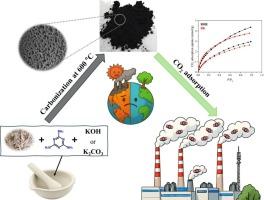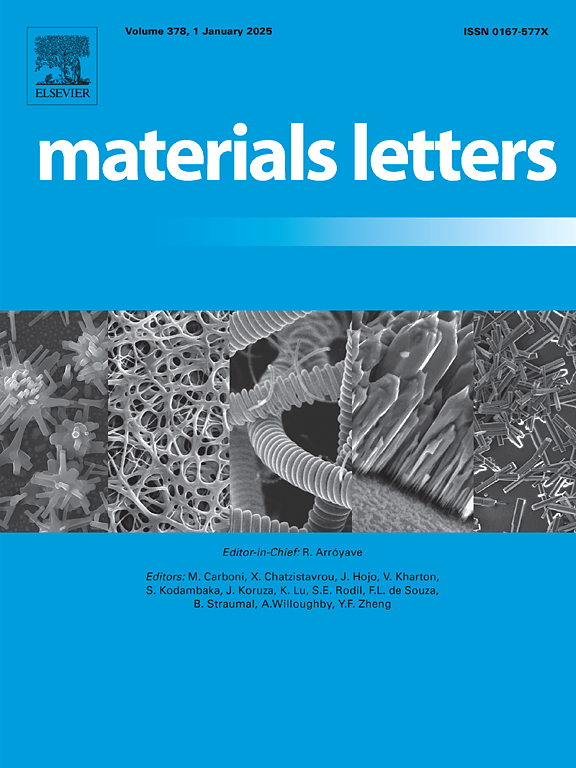The effect of the activating agent on the textural and chemical properties of ultra-microporous carbon materials on CO2 adsorption
IF 2.7
4区 材料科学
Q3 MATERIALS SCIENCE, MULTIDISCIPLINARY
引用次数: 0
Abstract
This study introduces a simple, solvent-free method for synthesizing nitrogen-doped ultra-microporous carbon materials using sugarcane bagasse as the carbon source and KOH or K2CO3 as the activating agent. The effects of different activating agent types on physical and chemical properties were discussed. The KOH-activated BOH material exhibited excellent CO2 adsorption properties (4.36 mmol/g at 0 °C and 2.96 mmol/g at 25 °C), with a high surface area (787.9 m2/g), ultra-micropore volume (0.27 cm3/g), and nitrogen content (8.02 at%). While the CO2 uptake of K2CO3-activated material (BK) demonstrates lower values of 3.47 mmol/g and 2.23 mmol/g, respectively. The findings suggest that the combination of higher nitrogen content and ultra-micropore volume enhances CO2 adsorption capacity, demonstrating the potential of KOH-activated carbon materials for efficient CO2 capture applications.

活化剂对超微孔碳材料结构和化学性能的影响对CO2吸附的影响
本研究以蔗渣为碳源,KOH或K2CO3为活化剂,介绍了一种简单、无溶剂的合成氮掺杂超微孔碳材料的方法。讨论了不同活化剂类型对其理化性能的影响。koh活化BOH材料具有优异的CO2吸附性能(0°C时为4.36 mmol/g, 25°C时为2.96 mmol/g),具有较高的比表面积(787.9 m2/g)、超微孔体积(0.27 cm3/g)和氮含量(8.02 at%)。而k2co3活化物质(BK)的CO2吸收量较低,分别为3.47 mmol/g和2.23 mmol/g。研究结果表明,高氮含量和超微孔体积的结合提高了CO2的吸附能力,证明了koh活性炭材料在高效捕集CO2方面的应用潜力。
本文章由计算机程序翻译,如有差异,请以英文原文为准。
求助全文
约1分钟内获得全文
求助全文
来源期刊

Materials Letters
工程技术-材料科学:综合
CiteScore
5.60
自引率
3.30%
发文量
1948
审稿时长
50 days
期刊介绍:
Materials Letters has an open access mirror journal Materials Letters: X, sharing the same aims and scope, editorial team, submission system and rigorous peer review.
Materials Letters is dedicated to publishing novel, cutting edge reports of broad interest to the materials community. The journal provides a forum for materials scientists and engineers, physicists, and chemists to rapidly communicate on the most important topics in the field of materials.
Contributions include, but are not limited to, a variety of topics such as:
• Materials - Metals and alloys, amorphous solids, ceramics, composites, polymers, semiconductors
• Applications - Structural, opto-electronic, magnetic, medical, MEMS, sensors, smart
• Characterization - Analytical, microscopy, scanning probes, nanoscopic, optical, electrical, magnetic, acoustic, spectroscopic, diffraction
• Novel Materials - Micro and nanostructures (nanowires, nanotubes, nanoparticles), nanocomposites, thin films, superlattices, quantum dots.
• Processing - Crystal growth, thin film processing, sol-gel processing, mechanical processing, assembly, nanocrystalline processing.
• Properties - Mechanical, magnetic, optical, electrical, ferroelectric, thermal, interfacial, transport, thermodynamic
• Synthesis - Quenching, solid state, solidification, solution synthesis, vapor deposition, high pressure, explosive
 求助内容:
求助内容: 应助结果提醒方式:
应助结果提醒方式:


